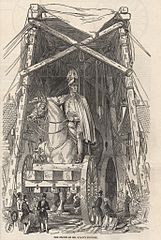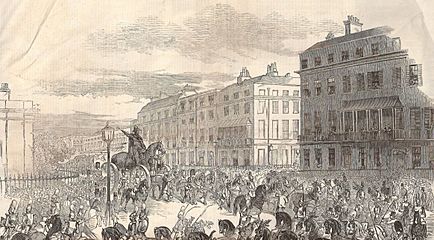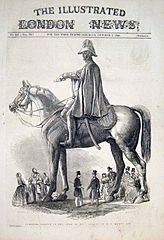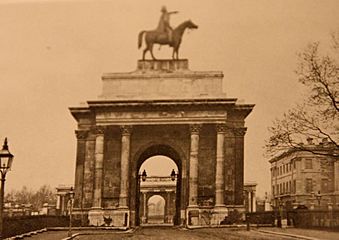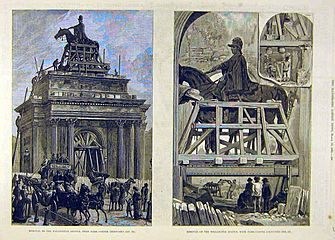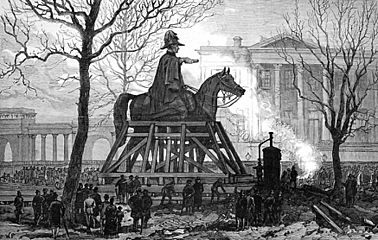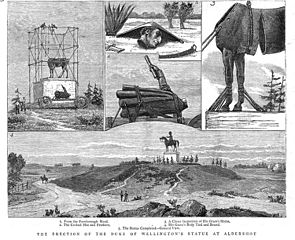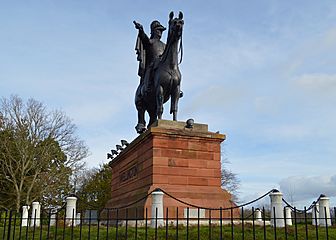Equestrian statue of the Duke of Wellington, Aldershot facts for kids
Quick facts for kids Equestrian statue of theDuke of Wellington |
|
|---|---|
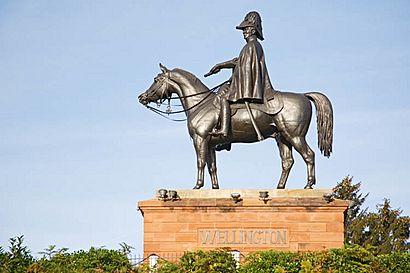
The Wellington Monument, Aldershot, showing the Duke of Wellington, holding a field marshal's baton, seated on his charger Copenhagen
|
|
| Artist | Matthew Cotes Wyatt |
| Subject | Arthur Wellesley, 1st Duke of Wellington |
| Dimensions | 910 cm × 790 cm (30 ft × 26 ft); 22 feet 8 inches ft diameter |
| Weight | 40 tonnes |
| Location | Aldershot |
| 51°15′12″N 0°46′48″W / 51.2534°N 0.7799°W | |
The Wellington statue in Aldershot is a huge monument. It honors Arthur Wellesley, 1st Duke of Wellington. He was a famous general who won the Battle of Waterloo. Later, he even became the prime minister of the United Kingdom. This amazing statue was made by Matthew Cotes Wyatt. When it was first shown in 1846, it was the biggest equestrian statue (a statue of a person on a horse) in Britain! It stood on the Wellington Arch in Hyde Park Corner, London.
How the Wellington Statue Was Made
Planning the Monument
In 1837, a group of people decided to create a memorial for the Duke of Wellington. They formed a committee, led by the Duke of Rutland. Their goal was to collect enough money to build a grand statue.
The famous sculptor Matthew Cotes Wyatt was chosen to create the artwork. The statue shows Wellington riding his horse, Copenhagen. This horse was very famous because Wellington rode him during the Battle of Waterloo.
Materials and Models
A lot of the bronze used for the statue came from French cannons. These cannons were captured during the Battle of Waterloo. They were melted down at Wyatt's special workshop.
The Duke of Wellington himself posed for the sculptor. However, his horse Copenhagen had already passed away. So, a different horse was used as a model instead. Some people at the time were not happy about this. They felt the statue's horse did not look much like Copenhagen.
Building the Statue in London
The statue was made at Wyatt's workshop in London. Work began in May 1840. Wyatt's son, James Wyatt, did a lot of the modeling.
The model for the statue was huge. It weighed more than three tons and was made of plaster of Paris. This plaster was shaped over a wooden frame, like the ribs of a ship. The model sat on a spinning platform 20 feet (6.1 m) wide. Artists could reach every part of it using a special adjustable stage. It took three years to finish the model.
Casting the Bronze Statue
To cast the statue, the model was lowered into a pit. This was done in a special foundry (a place where metal is melted and shaped). The statue was cast using bronze. Two large furnaces were needed to melt the metal. One could melt twelve tons, but a second, even bigger furnace was built.
Even with two furnaces, the statue was too big to cast in one piece. The horse's body and the Duke's lower legs were cast in two parts. The rest of the statue was made in six more pieces. Each piece was about 1 and 3 inches (25 and 76 mm) thick. The horse's legs were made solid to support the statue's huge weight.
The Statue's Size and Move to Hyde Park
This statue was the largest equestrian statue in Britain at the time. It stood 30 feet (9.1 m) tall. From Copenhagen's nose to tail, it was 26 feet (7.9 m) long. Around its middle, it measured 22 feet 8 inches (6.91 m). The entire statue weighed 40 tons.
In 1846, the statue was moved to Hyde Park Corner with a grand parade. It was carried on a huge, low carriage. This carriage had wheels 10 feet (3.0 m) wide and was built by the Royal Navy. One hundred men from the Scots Fusilier Guards pulled the carriage at first. Crowds cheered as it came onto the road. Then, twenty-nine horses took over, pulling the carriage to Hyde Park Corner. It took many hours to get the statue ready for lifting. The final lift and placement on the victory arch happened the next day.
-
The statue on Wellington Arch around the 1850s.
Moving the Statue to Aldershot
Why the Statue Was Moved
Many people thought the statue was too big for the arch at Hyde Park Corner. The architect who designed the arch, Decimus Burton, especially disliked it. He even left money in his will to have it removed! Queen Victoria also thought it spoiled the view from Buckingham Palace.
However, the statue could not be moved while the Duke of Wellington was still alive. Moving it would have seemed like an insult to him.
The Move to Aldershot Military Town
In 1882–83, the arch itself was moved a short distance. The Wellington statue was taken down and stored in Green Park. People then debated where it should go next.
In 1883, the Prince of Wales (who later became King Edward VII) had an idea. He suggested moving it to Aldershot Military Town. He said it would be "highly regarded by the Army" there. Parliament agreed with his idea. So, the statue was sent to Aldershot to be put back together. Many critics were relieved it was gone from the arch. They felt it was too big and did not fit the location.
New Home in Aldershot
During a visit to Aldershot, the Prince of Wales chose Round Hill as the statue's new home. This spot was near the Royal Pavilion and the Royal Garrison Church. Moving Wyatt's huge creation from London was a big challenge. But it was successfully moved and officially given to the British Army in August 1885. A large crowd watched the ceremony.
Restoring the Statue
In the late 1900s, the statue started to look old and worn. It was also mostly hidden by overgrown trees and bushes on Round Hill. In early 2004, Aldershot Garrison began a big project. They wanted to restore the statue to its original condition. The bushes were cleared away, and the statue was re-bronzed (given a new bronze finish).
The Friends of the Aldershot Military Museum now help care for the statue. They are supported by Aldershot Garrison, Rushmoor Council, and the Blackwater Valley Countryside Partnership.
As of June 2020, visiting the statue is a popular activity in Aldershot. It is rated as the 13th best thing to do in the town on Tripadvisor.


